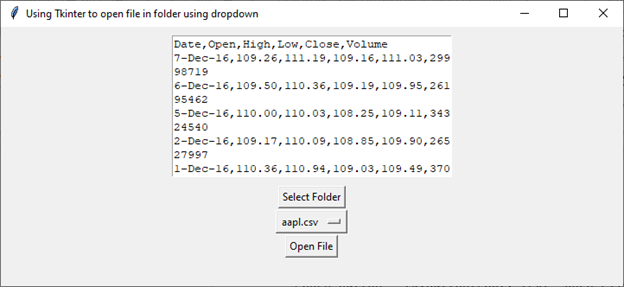
 Data Structure
Data Structure Networking
Networking RDBMS
RDBMS Operating System
Operating System Java
Java MS Excel
MS Excel iOS
iOS HTML
HTML CSS
CSS Android
Android Python
Python C Programming
C Programming C++
C++ C#
C# MongoDB
MongoDB MySQL
MySQL Javascript
Javascript PHP
PHP
- Selected Reading
- UPSC IAS Exams Notes
- Developer's Best Practices
- Questions and Answers
- Effective Resume Writing
- HR Interview Questions
- Computer Glossary
- Who is Who
How to use Tkinter to open file in folder using dropdown?
In this tutorial, we'll explore how to use Tkinter to build a simple file viewer that allows users to open files from a specific folder using a dropdown menu. By the end of this tutorial, you'll have a better understanding of Tkinter and how to create interactive file selection interfaces.
What is Tkinter?
Tkinter is the standard GUI toolkit that comes with Python. It provides a set of tools and widgets for creating graphical user interfaces. If you don't have Tkinter installed, you can do so using the following command
pip install tk
Now that you have Tkinter installed, let's dive into the process of building a file viewer.
Implementation Example
We'll start the process of building a file viewer by creating a basic Tkinter window with the necessary components. The Tkinter window will include a Text widget to display file content, a button to select a folder, a dropdown menu to select a file, and another button to open the selected file. Let's check out the python implementation code below
import tkinter as tk
from tkinter import filedialog
import os
def open_file():
selected_file = file_var.get()
file_path = os.path.join(folder_path, selected_file)
with open(file_path, 'r') as file:
content = file.read()
text.delete(1.0, tk.END) # Clear previous content
text.insert(tk.END, content)
def update_dropdown():
file_list = os.listdir(folder_path)
file_var.set(file_list[0] if file_list else "")
file_menu['menu'].delete(0, 'end')
for file_name in file_list:
file_menu['menu'].add_command(label=file_name, command=tk._setit(file_var, file_name))
def select_folder():
global folder_path
folder_path = filedialog.askdirectory()
if folder_path:
update_dropdown()
# Create the main window
root = tk.Tk()
root.title("Using Tkinter to open file in folder using dropdown")
root.geometry("720x300")
# Create a variable to store the selected file
file_var = tk.StringVar()
# Create a Text widget to display file content
text = tk.Text(root, wrap="word", height=10, width=40)
text.pack(pady=10)
# Create a button to select a folder
folder_button = tk.Button(root, text="Select Folder", command=select_folder)
folder_button.pack()
# Create a dropdown menu to select a file
file_menu = tk.OptionMenu(root, file_var, "")
file_menu.pack()
# Create a button to open the selected file
open_button = tk.Button(root, text="Open File", command=open_file)
open_button.pack()
# Run the Tkinter event loop
root.mainloop()
This code sets up a basic Tkinter window with the necessary components for our file viewer. The select_folder function uses the filedialog.askdirectory method to prompt the user to select a folder, and the update_dropdown function updates the dropdown menu with the list of files in the selected folder.
Output
On running this code, you will get the following output window

Exploring the Code
Let's break down the key components of the code
open_file function This function is called when the "Open File" button is clicked. It retrieves the selected file from the dropdown menu, constructs the file path, reads the file's content, and displays it in the Tkinter Text widget.
update_dropdown function This function is responsible for updating the dropdown menu with the list of files in the selected folder. It sets the default selected file to the first file in the list and adds commands to the dropdown menu for each file.
select_folder function This function is triggered when the "Select Folder" button is clicked. It opens a dialog for the user to choose a folder. Once a folder is selected, it updates the dropdown menu with the files in that folder.
Tkinter widgets The Text, Button, and OptionMenu widgets are used to create the user interface. The StringVar (file_var) is used to store the selected file.
Conclusion
In this tutorial, we've explored the process of building a file viewer with Tkinter in Python. We've covered the basic setup of the Tkinter window, including creating buttons, dropdown menus, and handling user interactions.

